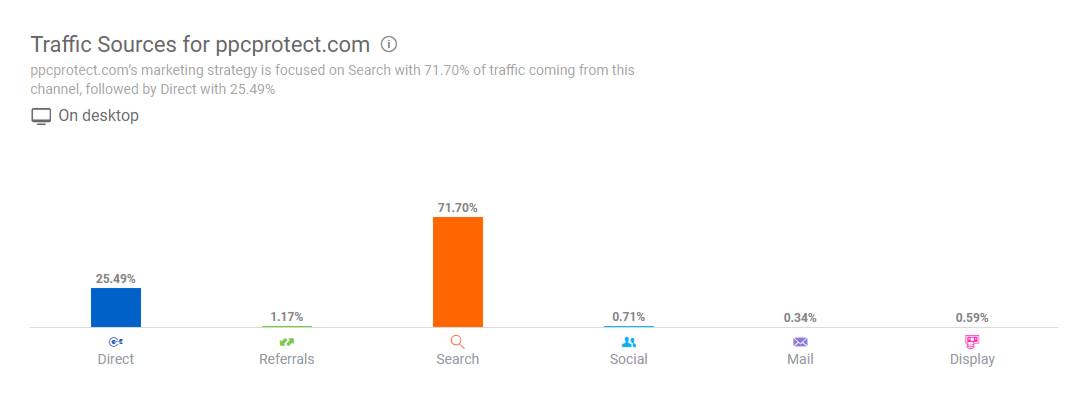Display ads. Are they a cheap alternative to search ads to help drive conversions, or are they just a huge waste of money?
If you don’t have time to read this article, and want to skip to the good stuff, then download our free list of 50,000+ exclusions for the Google Ads display network.
With their vast reach, low cost per click, and colorful imagery, are they really as profitable as other ad campaigns?
Believe it or not, display ads have the highest levels of fraudulent activity when compared to any other type of ad campaign.
In this eye-opening article, we’ll be taking a look at why display ads might not be as good as they seem. To get things started, we’ll take a look at what click fraud is and how it’s plaguing millions of advertisers.
Following on from that, we’ll look at why display ads have the highest level of fraud and how you can fight back.
But that’s not all, we’ll also be giving away an awesome resource to every reader that will significantly help improve the profitability of their display campaigns.
What Is Click Fraud?
Click fraud is a type of ad fraud specific to pay-per-click (PPC) campaigns and has been around since the advertising model was invented.
As the PPC name suggests, advertisers who run these types of campaigns pay for every click they receive.
But what if a click isn’t legitimate and is from an automated robot, or a malicious repeat clicker?
You might think advertising networks already stop this from happening, but that certainly isn’t always the case.
Over the past several years there have been various lawsuits with the likes of Google and Facebook over fraudulent clicks.
Just this year there is an ongoing case between Motogolf.com vs Top Shelf relating to click fraud activity, and in 2006 alone Google had to pay out $90 million to Lanes Gifts and Collectibles for the click fraud they experienced.
With any advertiser at the risk of receiving bogus clicks, it’s clear to see why it’s such a big problem in the industry. Ad networks want to sell as many clicks as possible to make their money, while advertisers only want to pay for clicks they deem legitimate.
Who’s Responsible for Click Fraud?
When it comes to who is behind click fraud, there are several key participants, each with a different motive.
Competitors
One of the biggest culprits of click fraud can be defined as competitors, or anyone who is competing with you on the same keyword.
Since competitors are running PPC ads, they understand that every click comes with a cost. By purposely clicking on other advertiser’s ads, they can effectively waste budget and reduce marketing exposure.
There’s a fine balance to be had here between increasing your competitors’ CTR too much that their CPC begins to decrease, but get the balance right and the attack can be devastating.
Customers
Disgruntled customers can wreak havoc on any type of ad campaigns with their continuous clicking.
Whether they received bad service, or just hate the company, these continuous clicks can quickly add up – and can easily look like legitimate browsing activity at first glance.
App Developers
In recent years the growth of mobile apps has been unprecedented. When it comes to making money from the apps, aside from in-app purchases, many developers resort to using ads to make money.
Yet many developers use unethical practices such as ad stacking, ad injections, and clicking ads in the background to fool advertisers out of their ad spend.
Organized Crime
The drug trade is so last decade.
Ad fraud is now the second-largest organized criminal enterprise in the world and growing each year – yet criminals are much less likely to get caught.
Over the past several years there have been numerous click fraud schemes developed by criminal organizations including Drainerbot and Methbot, resulting in tens of millions of dollars of losses for advertisers.
How Click Fraud Affects Advertisers
On the surface, click fraud might not seem like a big deal, but it goes much further than just being an inconvenience – it has a huge cost attached.
Some may argue that getting spend refunds should be easy if you present the ad network with evidence. But in reality, anyone who has tried this will know how futile it is.
Click fraud can also skew marketing data to the point where it becomes useless to use for planning.
“When your PPC marketing data is skewed by fraud, it becomes very difficult to make actionable decisions based on it.”
If the marketer isn’t aware that they’ve been the victim of click fraud, then they could end up making marketing decisions based on bad data.
Finally, if click fraud becomes too big of a problem for advertisers, in some cases it can stop them from running paid ads altogether.
The Wild West of Display Advertising
Display advertising has been around just as long as PPC advertising.
From the early days of placing fixed banners on websites for a monthly fee, display advertising is now a complex system of AI and exchanges.
One of the largest display advertising networks out there is Google Ads and its Google Display Network. As of 2020, their display network has more than 2 million partner sites and reaches over 90% of all web users.
With a huge demand for display advertising, Google allows webmasters to join its display network with relatively low requirements.
As long as they have a clean website with legitimate content, any webmaster can start display ads on behalf of Google.
Compared to Google’s search ads, display advertising is generally a lot cheaper but also works differently.
Instead of the ads showing up on Google’s official search properties, they show up on third-party websites, allowing webmasters to make advertising revenues.
The Unethical Webmaster
Not every webmaster who joins a display network has innocent intentions. Some are purposely trying to game the system and waste advertiser’s spend.
Known as ad farms, these websites can be spun up extremely quickly and easily.
Currently, any webmaster who displays a network’s ads on their website will receive around 68% of the revenue from every click, although it varies network to network. This means that in order to make more money, the webmaster needs their ads to get more clicks.
There are several ways to do this. Some are ethical but time-consuming. Others are fast and easy – which involves defrauding advertisers.
The go-to strategy for many unethical webmasters is to simply click their own ads. By clicking on their ads, they receive money from networks while having no intention of ever purchasing the advertiser’s products or services.
Because clicking on ads can be a slow process, and most reputable networks have systems in place to stop this very obvious fraudulent activity, many webmasters have gone a step further to create automated bots replicating human-like behaviors.
These bots automatically click ads without the need for human input whilst mimicking legitimate users, and can significantly increase webmaster earnings whilst avoiding in-built ad network fraud detection systems.
How to Detect Ad Farms
If you’re running ads on display networks, then manually vetting and inspecting websites is a must.
Although most networks do manually vet all websites that join their program, it’s usually a one-off. This means that as soon as they are approved by the network, they can start switching to shady tactics and go unnoticed.
If you’re having trouble detecting if a third party website is legitimate or an ad farm, then here are some strategies to help you out.
Use SimilarWeb
The first way to get an idea of a website is real or an ad farm is to head on over to SimilarWeb.
This gives you an insight into a website’s traffic sources and shows you where most of the users are coming from.

Legitimate websites will usually get most of their traffic from search, social, or referrals unless they are a big brand name.
This means if you spot a website getting 90% of their traffic from direct visits they’re either a huge well-known site, or there’s something fishy going on. It’s not a perfect detection method, but it’s a good starting point.
Data Outliers
Keeping a close eye on your display network campaign metrics can give you plenty of hints about display partner sites.
The most obvious thing to look out for is an above-average click-through rate. Currently, the average click-through rate on the Google display network sits around 0.5% but can vary depending on the industry.
Ad farms typically have a higher CTR, often with peaks & troughs following the same patterns for weeks on end.
Visual Inspections
The final way to check for potential ad farms is to give the website a visual inspection. This might seem like a slow process, but it will definitely give you the best results.
The most important things to look out for is where the ads are placed and how many are displayed per page. Ad farms will tend to go overboard on the ads and purposely stack ads on top of each other or place them in front of buttons.
If the website looks like this:

Then it’s most definitely an ad farm.
Fighting Back Against Ad Fraud
Now you understand the dangers of click fraud and how unethical webmasters are using display ads to make themselves a fortune, how do you protect yourself?
Networks have their own invalid clicks detection algorithms, but naturally, they are designed in their favor and aren’t an independent verification method. If you really want to get the most out of your monthly ad budget, then you need to be proactive.
Exclusion Lists
Your primary weapon against unethical webmasters and low performing sites is an exclusion list. By adding websites to this list, you’re effectively telling the network not to place any ads on those websites.
The hard bit of this strategy is going through the potential millions of partner sites to determine which are worth your money.
Using an existing exclusions list is a good place to start, and then fine-tuning it for your own needs.
Ads.txt
A recent new security measure that has been introduced to the display advertising industry is the ads.txt file.
This file lists the authorized digital sellers (ADS) that are authorized to resell a website’s ad inventory.
Introduced to tackle the growing problem of domain spoofing with display ads, the goal is to give more confidence to advertisers buying ads.
Checking websites have ads.txt files before blindly running display ads on them is another strategy to significantly reduce the amount of ad fraud.
Although it is by no means a guarantee that the site is “clean”. Some ads.txt files have been known to contain malicious sites themselves or used in schemes such as the 404bot.
Allow Lists
The opposite of exclusion lists, the allow list tells networks which websites to only show your ads on. If you’re very picky about what website you want your ads associated with then this is a surefire way to have full control over your ads.
Similar to the exclusion lists, you may have to go through a lot of websites to check them all. But at least you know your ads will only be shown on legitimate websites.
Audit Your PPC Campaigns for Free
If you’re running PPC campaigns then you’re likely being impacted by click fraud across both your search and display campaigns.
Luckily, you can now audit your campaigns for fraud completely free with PPC Protect and their 14-day trial.
Take advantage of powerful machine learning & neural network systems to identify the fraudulent activity that ad networks and other platforms miss.
Sign up for your free 14-day PPC Protect trial here.
Stop fraud with our 50,000+
display placement exclusions list
The opinions expressed in this article are the sponsor's own.



